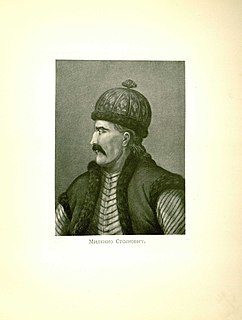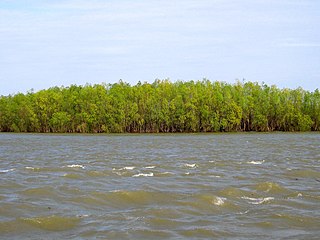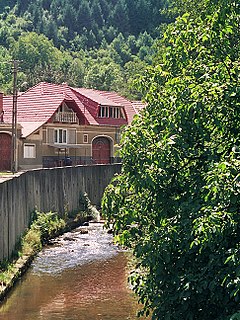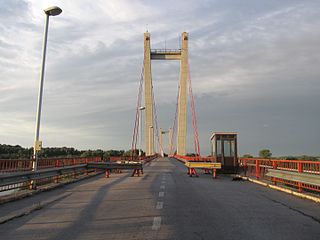See also
| Sovereign states |
| |
|---|---|---|
| States with limited recognition | ||
| Dependencies and other entities | ||
| Geography of Romania |
| Topography |
| Hydrography |
| Climate |
This is a list of islands of Romania .

Milenko Stojković was a Serbian revolutionary and bimbaša in the First Serbian Uprising early in the 19th century. He is most famous for executing four dahije tyrants during the start of the First Serbian Uprising, in vengeance for the "Slaughter of the Knezes".

The Iron Gates is a gorge on the river Danube. It forms part of the boundary between Serbia and Romania (north). In the broad sense it encompasses a route of 134 km (83 mi); in the narrow sense it only encompasses the last barrier on this route, just beyond the Romanian city of Orșova, that contains two hydroelectric dams, with two power stations, Iron Gate I Hydroelectric Power Station and Iron Gate II Hydroelectric Power Station.

The Great Brăila Island is an island on the Danube river in the Brăila County, Romania. It has on average 57.9 km (36.0 mi) length and 18.6 km (11.6 mi) width, with a total area of 710 km2 (270 sq mi). The two river branches which separate it from the mainland are Măcin Branch and Vâlciu Branch.

The Romanian Plain is located in southern Romania and the easternmost tip of Serbia, where it is known as the Wallachian Plain. Part of the historical region of Wallachia, it is bordered by the Danube River in the east, south and west, and by the Getic Plateau in the north. Bucharest, the capital of Romania, is located in the central part of the Romanian Plain. It is contiguous to the south with the Danubian Plain, in Bulgaria. This area is also sometimes referred to as the Danubian Plain(Câmpia Dunării) in Romanian, though this designation is not specific, because the Danube flows through a number of plains along its course, such as the Hungarian Plain, as well as the Bavarian Lowland, also called the Danubian Plain.

Cibin is a river in central Romania, in the south part of Transylvania. Its source is close to the highest peak in the Cindrel Mountains of the Southern Carpathian Mountains. Upstream from its confluence with the Râul Mic, the river is also called Râul Mare. The river flows entirely in Sibiu County.

Chilia Veche is a commune in Tulcea County, Northern Dobruja, Romania, in the Danube Delta. It gave its name to the Chilia branch of the Danube, which separates it from Ukraine. It is composed of four villages: Câșlița, Chilia Veche, Ostrovu Tătaru and Tatanir.

Ada Kaleh was a small island on the Danube in what is modern Romania, that was submerged during the construction of the Iron Gates hydroelectric plant in 1970. The island was about 3 kilometres (1.9 mi) downstream from Orșova and was less than two kilometers long and approximately half a kilometer wide, inhabited by Ottoman Turkish speaking Muslim's from all parts of the Ottoman Empire, locally called Turks, there were also family ties to the Turkish Muslim population of Vidin and Ruse, Bulgaria, due to exogamy marriages.
Sacalin Island is a newly formed island in the Black Sea, right off the coast of the Romanian Danube Delta, off the Sfântu Gheorghe branch. Initially Sacalin was made up of two smaller islands, Sacalinu Mare and Sacalinu Mic. In time, however, the two merged into one continuous landmass. The Romanian government has declared the area an ecological reserve and no settlement is permitted on the island.

Islaz is a commune in southern Romania, located in the southwestern Teleorman County, 10 km (6.2 mi) west of Turnu Măgurele. It is part of the historical province Oltenia, and is composed of two villages, Islaz and Moldoveni.
Jean Constantin was a well-known Romanian comedian of Greek ethnicity. Constantin was born in Techirghiol, and died in Constanța.
The Bega Veche is a left tributary of the river Bega in Romania and Serbia. It discharges into the canalized part of the Bega near Zrenjanin. In Romania, its length is 107 km (66 mi) and its basin size is 2,108 km2 (814 sq mi). The lower part of the river is the old course of the Bega. It drains the area north of the city of Timișoara. It flows through the villages Comeat, Bogda, Charlotenburg, Remetea Mică, Fibiș, Pișchia, Cerneteaz, Covaci, Sânandrei, Săcălaz, Beregsău Mare, Beregsău Mic, Bobda and Cenei in Romania, and through Hetin and Banatski Dvor in Serbia. Many rivers of the Banat plain have been channelized. The channelization started in the 18th century and has continued in the following centuries. At present most of these rivers have been integrated into the system of drainage channels of the area. This development has significantly modified the original natural river network.

The Danube is the second-longest river in Europe, after the Volga in Russia. It flows through much of Central and Southeastern Europe, from the Black Forest into the Black Sea. Its longest headstream Breg rises in Furtwangen im Schwarzwald, while the river carries its name from its source confluence in Donaueschingen onwards.
Ostrovul Mare is a natural reserve, an island on the Danube together with Ostrovul Calnovăț, in the proximity of Islaz, Teleorman County. On the island is breeding a colony of pygmy cormorant.

The Ostrovul Mare Bridge is a bridge in Romania over the Gogoșu branch of the Danube. It is intended for complementary access to the Ostrovu Mare Island and the Iron Gate II Hydroelectric Power Station, respectively to the local border crossing point between Romania and Serbia.
Hîrtopul Mare is a commune in Criuleni District, Moldova. It is composed of two villages, Hîrtopul Mare and Hîrtopul Mic.
Șimian is a river island on the Danube belonging to Romania, just downstream of the city of Turnu Severin and overlooking the town of Șimian. The island is home to the reconstructed fortress relocated from the historic Ada Kaleh island, when it was due to be submerged by the Iron Gate I dam building in 1968. For that reason, it is also known as the "New Ada Kaleh", although the ambitious resettlement plan has never been completed.

Mayda Insula is an island in the Kraken Mare, a body of liquid composed primarily of methane, on Saturn's largest moon Titan. Mayda Insula is the first island (insula) to be named on a planet or moon other than Earth.

Tătaru Mare Island is a Romanian island in the northernmost branch of the Danube Delta.

The territorial evolution of Romania includes all the changes in the country's borders from its formation to the present day. The precedents of Romania as an independent state can be traced back to the 14th century, when the principalities of Moldavia and Wallachia were founded. Wallachia during its history lost several portions of its territory, either to the Ottomans or the Habsburgs. However, this land would be later essentially recovered in its entirety. Moldavia, on the other hand, suffered great territorial losses. In 1774, the Habsburgs invaded Bukovina and annexed it one year later, and in 1812, the Russian Empire took control of Bessarabia. Both territories were later exposed to powerful colonization policies. The principalities declared unification in 1859 as the Principality of Romania. This new state sought independence from the Ottoman Empire's vassalage, and in 1878, it fought a war against it alongside Russia. However, the latter would annex Southern Bessarabia, which was recovered decades before. Romania received Northern Dobruja as compensation, and would wage a war for the southern part against Bulgaria in 1913.
Regep Ağa was an Ottoman general of Romanian origin.